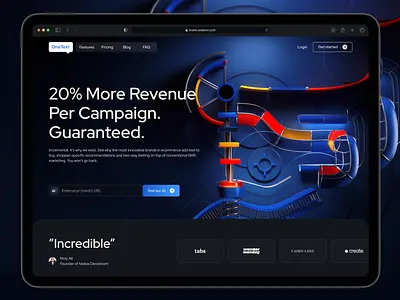In today’s fast-paced digital world, users make split-second decisions. A few taps, scrolls, or swipes are all it takes to form an opinion about your app or website. This is where UI (User Interface) and UX (User Experience) design play an irreplaceable role—not just in aesthetics, but in determining the success or failure of your digital product
Startups, businesses, and even large enterprises often focus heavily on functionality and development. While those are undoubtedly essential, design is what connects your users to your core offering. Whether it's a customer browsing an e-commerce platform or an employee using an enterprise dashboard, UI/UX design determines how seamless, intuitive, and enjoyable that interaction will be.
 Lightning-fast
load times with optimized images and code.
Lightning-fast
load times with optimized images and code.
 Clean and
semantic HTML for better crawler indexing.
Clean and
semantic HTML for better crawler indexing.
 Responsive
design that enhances mobile engagement.
Responsive
design that enhances mobile engagement.
 Intent-based
UX that aligns with keyword search behavior.
Intent-based
UX that aligns with keyword search behavior.
 Accessible
navigation and structured content flow.
Accessible
navigation and structured content flow.
Design isn’t just visual — it’s strategic. The best-performing pages on Google in 2024 are not just beautiful; they’re designed to be found, understood, and acted upon.
Let’s explore how investing in the right kind of website development, whether for e-commerce or lead generation, can unlock consistent business growth.
A website is always accessible—unlike a physical store, it never closes. Customers can interact with your brand anytime, whether they’re browsing products at midnight or requesting a quote during their lunch break. This 24/7 availability means more opportunities to connect, serve, and convert users without being restricted by time or geography.
A well-developed website ensures a seamless user experience with quick load times, mobile responsiveness, and intuitive navigation. When users have a smooth experience, they stay longer and are more likely to convert.
First Impressions Matter
When users land on your mobile app or website, the first 10 seconds are crucial. If the interface looks outdated, cluttered, or unintuitive, users are more likely to bounce—even if your backend is strong.
Good UI design ensures:
 Clean layout and logical structure
Clean layout and logical structure Visual consistency in colors, fonts, and spacing
Visual consistency in colors, fonts, and spacing Responsiveness across devices
Responsiveness across devices Quick loading and performance optimization
Quick loading and performance optimization
UX complements this by ensuring that the user's journey feels natural, fulfilling their goals with minimal friction.
What Makes UI/UX So Important?
Here are some key reasons why design isn’t just a “nice to have”—it’s a must-have:
 Retention and Engagement: Users are more likely to return to an app or website that feels smooth, fast, and intuitive.
Retention and Engagement: Users are more likely to return to an app or website that feels smooth, fast, and intuitive. Conversion Rates: A simplified checkout flow or an engaging onboarding process can significantly boost sales or signups.
Conversion Rates: A simplified checkout flow or an engaging onboarding process can significantly boost sales or signups. Customer Trust: A professionally designed UI builds credibility, while poor UX can drive users away—even if the product is strong.
Customer Trust: A professionally designed UI builds credibility, while poor UX can drive users away—even if the product is strong. Cost Efficiency: Investing in good design early on reduces rework, user confusion, and support costs.
Cost Efficiency: Investing in good design early on reduces rework, user confusion, and support costs. Competitive Advantage: In saturated markets, design can be the differentiator that keeps users loyal to your brand.
Competitive Advantage: In saturated markets, design can be the differentiator that keeps users loyal to your brand.
UX: Beyond Just “User-Friendly”
Many believe UX is just about navigation or layout. In reality, it spans every touchpoint of a user’s interaction, including:
 How long it takes a user to complete a task (task flow)
How long it takes a user to complete a task (task flow) How intuitive it is to find information
How intuitive it is to find information How the app handles errors (like empty carts or failed logins)
How the app handles errors (like empty carts or failed logins) The emotional journey—does the user feel frustrated, satisfied, or delighted?
The emotional journey—does the user feel frustrated, satisfied, or delighted?
Great UX reduces cognitive load—the mental effort required to navigate or use your platform. This is vital in mobile apps, where screen space is limited and attention spans are shorter.
Mobile-First Design: Not Just a Trend, But a Standard
With more than 60% of internet traffic coming from mobile devices, mobile-first UI/UX design is no longer optional. Mobile design has unique considerations:
 Touch Interactions: Tap, swipe, pinch-to-zoom need to feel fluid and intuitive.
Touch Interactions: Tap, swipe, pinch-to-zoom need to feel fluid and intuitive. Screen Real Estate: Prioritize content and functions that matter most.
Screen Real Estate: Prioritize content and functions that matter most. Battery & Data Usage: Lightweight design and optimal loading can reduce app churn.
Battery & Data Usage: Lightweight design and optimal loading can reduce app churn. Accessibility: Easy-to-read fonts, high contrast UI, and voice support go a long way in improving inclusivity.
Accessibility: Easy-to-read fonts, high contrast UI, and voice support go a long way in improving inclusivity.
UX on mobile apps also focuses on microinteractions—like feedback on tapping a button, animations during screen transitions, and loading indicators—all of which make the experience feel polished and human.
Case in Point: UI/UX in Real-World Scenarios
An e-commerce app redesigned its cart page to remove distractions and improved button placement. Result? A 22% increase in checkout completion.
A fintech company simplified its user onboarding with progress indicators and helpful tooltips. The user drop-off rate fell by 40%.
A food delivery app added subtle UI feedback (like vibrations and animations). Customer ratings jumped on app stores, boosting organic installs.
These improvements are often small in isolation but create compounded user satisfaction when combined.
UI/UX Design Principles That Matter
 Clarity: The user should always know where they are and what they can do next.
Clarity: The user should always know where they are and what they can do next. Consistency: Navigation, icons, and buttons should behave the same across the platform.
Consistency: Navigation, icons, and buttons should behave the same across the platform. Feedback: Provide clear signals when actions are taken (loading states, confirmations).
Feedback: Provide clear signals when actions are taken (loading states, confirmations). Simplicity: Less is more. Keep it focused, especially on mobile.
Simplicity: Less is more. Keep it focused, especially on mobile. Accessibility: Consider users with disabilities. Use alt text, screen reader compatibility, and inclusive design.
Accessibility: Consider users with disabilities. Use alt text, screen reader compatibility, and inclusive design.
UI/UX Design Is an Ongoing Process
UI/UX isn’t something you design once and forget. It requires:
 User Testing: Regular feedback from real users helps validate assumptions.
User Testing: Regular feedback from real users helps validate assumptions. Analytics: Monitoring heatmaps, bounce rates, and conversion funnels reveals bottlenecks.
Analytics: Monitoring heatmaps, bounce rates, and conversion funnels reveals bottlenecks. Iteration: Continuous design and A/B testing to refine and enhance.
Iteration: Continuous design and A/B testing to refine and enhance.
Just like code, UI/UX evolves with your product and user base.
Tools and Platforms That Empower Design
 Figma, Adobe XD, Sketch: For collaborative UI design and prototyping.
Figma, Adobe XD, Sketch: For collaborative UI design and prototyping. InVision, Marvel: For user flow simulation and stakeholder demos.
InVision, Marvel: For user flow simulation and stakeholder demos. Hotjar, CrazyEgg: For visual heatmaps and behavioral insights.
Hotjar, CrazyEgg: For visual heatmaps and behavioral insights. Google Analytics, Mixpanel: For user journey tracking and event-based analysis.
Google Analytics, Mixpanel: For user journey tracking and event-based analysis.
Designers and developers working together in agile sprints ensure that UX is not an afterthought but a core part of product development.
Over time, SEO becomes a cost-effective way to generate consistent traffic and leads.
Your website is a content hub—blogs, videos, resources, and guides can all be hosted to educate and engage visitors. High-quality content also boosts your SEO rankings and positions you as an expert in your field.
Write blogs targeting industry-specific problems and solutions
Share customer stories and success case studies
Offer downloadable guides, brochures, or eBooks to capture leads
Embed video explainers or product tutorials to increase time-on-site
Content marketing not only builds trust but also nurtures leads until they’re ready to take action.
A modern website isn’t a standalone asset—it integrates seamlessly with tools and platforms to create powerful automations. From marketing to operations, your website can streamline processes across your business.
Connect with CRM systems to track and manage leads
Integrate live chat or AI chatbots for instant support
Link with email marketing tools for newsletter and campaign automation
Use analytics tools to track performance and user behavior
These integrations help reduce manual work, improve customer experience, and drive better results.
Today’s internet users expect a smooth mobile experience. With more than 60% of traffic coming from mobile devices, your site needs to be fully responsive across screen sizes. A mobile-first approach ensures that your audience can browse, buy, or inquire from anywhere.
Touch-friendly buttons and navigation
Fast loading pages on mobile networks
Easy form submissions on small screens
Consistent design experience across devices
Ignoring mobile optimization can lead to high bounce rates and missed opportunities.
Unlike traditional advertising, a website provides you with detailed performance metrics. You can measure every action users take and adjust your strategy based on real-time data.
Track how many users visit your website and which pages they visit
Monitor conversions—whether it's a product purchase or a form submission
Identify traffic sources (Google, social media, direct visits)
Understand user behavior and improve the journey accordingly
This level of visibility enables data-driven decision-making that improves ROI over time.
Whether your business goals are to increase online sales, generate leads, build brand awareness, or educate customers, your website is the foundation for all of it. A custom-developed site ensures that your brand message is communicated effectively, your business goals are met, and your customers have a smooth journey from first click to final conversion.
Design Smart to Rank Strong in 2024
If the answer is “yes,” you’re already on the path to building something people will not just use—but love.
Conclusion: Design Is the Experience
In a market flooded with options, a good-looking app isn’t enough—the user experience must be flawless. Whether it's a lead-generation website or a scalable mobile application, UI/UX design determines how your users feel, act, and return.
For startups and enterprises alike, investing in thoughtful, research-backed UI/UX design is investing in user loyalty, brand value, and long-term business success.
So next time you launch a digital product, ask yourself: Is this intuitive? Does this delight the user? Would I use it again?




